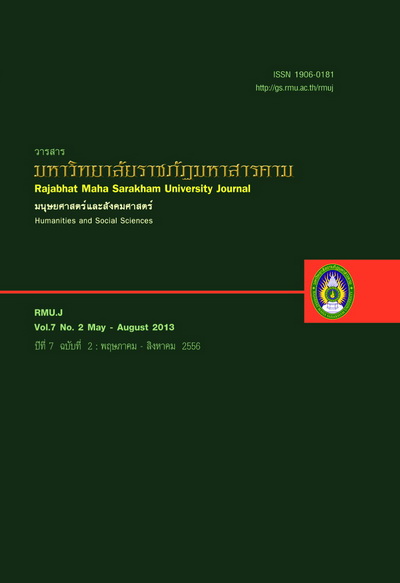การวิเคราะห์มโนทัศน์ที่คลาดเคลื่อนทางการเรียนคณิตศาสตร์ เรื่อง ความรู้เบื้องต้นเกี่ยวกับจำนวนจริง ของนักเรียนชั้นมัธยมศึกษาปีที่ 2
Main Article Content
บทคัดย่อ
บทคัดย่อ
การวิจัยครั้งนี้ เพื่อทำการวิเคราะห์มโนทัศน์ที่คลาดเคลื่อนทางการเรียนคณิตศาสตร์ เรื่อง ความรู้เบื้องต้นเกี่ยวกับจำนวนจริง ของนักเรียนชั้นมัธยมศึกษาปีที่ 2 โดยมีวัตถุประสงค์เฉพาะดังนี้ คือ เพื่อศึกษาแบบรูป สาเหตุ และแนวทางแก้ไขมโนทัศน์ที่คลาด เคลื่อนทางการเรียนคณิตศาสตร์ กลุ่มเป้าหมายที่ใช้ในการวิจัยครั้งนี้ ได้แก่ นักเรียนชั้นมัธยมศึกษาปีที่ 2 โรงเรียนฆ้องชัยวิทยาคม จังหวัดกาฬสินธุ์ ที่เรียนในภาคเรียนที่ 2 ปีการศึกษา 2554 จำนวน 1 ห้องเรียน จำนวนนักเรียน 36 คน ตัวแปรที่ใช้ในการวิจัย คือ มโนทัศน์ที่คลาดเคลื่อนทางการเรียนคณิตศาสตร์ เครื่องมือที่ใช้ในการวิจัยครั้งนี้ ได้แก่ แบบทดสอบ วิชาคณิตศาสตร์พื้นฐาน เรื่อง ความรู้เบื้องต้นเกี่ยวกับจำนวนจริง ชั้นมัธยมศึกษาปีที่ 2 เป็นแบบอัตนัย จำนวน 15 ข้อ แบบสัมภาษณ์แบบมีโครงสร้าง และแบบ ประเมินความเหมาะสมของสาเหตุและแนวทางในการแก้ไขในมโนทัศน์ที่คลาดเคลื่อนทางการเรียนคณิตศาสตร์ วิเคราะห์ข้อมูลด้วย การวิเคราะห์เนื้อหาและนำเสนอด้วยวิธีพรรณนาวิเคราะห์ ผลการวิจัยพบว่า
1. แบบรูป แบบรูปของมโนทัศน์ที่คลาดเคลื่อนพบ 5 แบบรูป คือ 1) ด้านการบิดเบือนทฤษฎีบท กฎ สูตร บทนิยาม และ สมบัติ 2) ด้านข้อผิดพลาดในเทคนิคการทำ 3) ด้านการใช้ข้อมูลผิด 4) ด้านการตีความด้านภาษา และ 5) ด้านขาดการตรวจสอบใน ระหว่างการแก้ปัญหา
2. สาเหตุ สาเหตุของการเกิดมโนทัศน์ที่คลาดเคลื่อนทางการเรียนคณิตศาสตร์ คือ นักเรียนขาดความเข้าใจพื้นฐานเกี่ยวกับ นิยาม และสมบัติของจำนวนตรรกยะ จำนวนอตรรกยะหลักการหารากที่สอง และหลักการหารากที่สาม ซึ่งเกิดจากการขาดความ ระมัดระวังในการคิดคำนวณ ขาดการไตร่ตรองในการให้เหตุผล และขาดความรอบคอบในการทำแบบทดสอบ แล้วจึงทำให้เกิดข้อผิด พลาดที่เกิดจากการ ละเลยการใช้ข้อมูลที่จำเป็นในขั้นตอนการแก้ปัญหา หรือว่าทำผิดคำสั่งโดยหาคำตอบในสิ่งที่ไม่ต้องการ และเกิด จากการคัดลอกโจทย์ผิด อีกทั้งยังเกิดจากการแปลความหมายสัญลักษณ์ สูตร กฎ ทฤษฎี ที่แตกต่างไปจากข้อตกลงที่เป็นที่ยอมรับ โดยทั่วไป หรือเกิดจากการตีความจากความเข้าใจที่ได้มาจากแนวความคิดหรือความรู้ที่ไม่ถูกต้อง ความรู้ที่ไม่สมบูรณ์ คลุมเครือ จน ทำให้เกิดข้อผิดพลาดขึ้น หรือเกิดจากการแสดงขั้นตอนในการทำแบบทดสอบถูกต้อง แต่คำตอบที่ได้มาผิด หรือทำแบบทดสอบไม่ เสร็จสิ้นสมบูรณ์ หรือขั้นตอนในการทำแบบทดสอบผิด แต่คำตอบที่ได้มานั้นถูกต้อง
3. แนวทางแก้ไขปัญหา แนวทางการแก้ไขมโนทัศน์ที่คลาดเคลื่อนทางการเรียนคณิตศาสตร์ คือ โดยการสอนเสริม ให้ นักเรียนได้เรียนรู้โดยการค้นพบด้วยตนเอง ใช้ชุดการเรียนการสอนเป็นรายบุคคล การใช้บทเรียนสำเร็จรูป บทเรียนแบบการ์ตูน การ เรียนแบบร่วมมือ และการใช้กิจกรรมกลุ่มเข้ามาช่วย เช่น การแข่งขันกันเล่นเกม การทำโครงงาน เพื่อสร้างความตระหนักและเล็งให้เห็นความสำคัญและผลเสียของการขาดความระมัดระวังและความรอบคอบในการคำนวณ โดยการเสริมแรงทางบวก โดยการชมเชยการให้คะแนน หรือ ให้รางวัล มีการฝึกสมาธิก่อนเรียน และฝึกทักษะโดยใช้แบบฝึกทักษะ จากง่ายไปหายาก เพื่อให้นักเรียนได้เรียนรู้กระบวนการในการค้นพบ รู้จักสังเกต เปรียบเทียบ และก่อให้เกิดความคิดสร้างสรรค์ แล้วสามารถสรุปความคิดนั้นได้ด้วยตนเอง
คำสำคัญ : ระดับการคิด
ABSTRACT
This research aimed to analyze 8th grade students' misconceptions in mathematics learning of basic knowledge on real numbers; specifically, to study patterns of their misconceptions and causes, and to seek solutions or guidelines for solving these misconceptions. The target group for this research consisted of 36 8th grade students studying at Kongchai Wittayakom School, Kalasin Province, in the second semester of the academic year 2011. The variables of this study were misconceptions in mathematics learning. The instruments used in this study were a 15-item subjective test of basic knowledge on real numbers for 8th grade students, a structured-interview form, and an assessment form for assessing appropriateness of causes and guidelines for solving misconceptions. Content analysis was used to analyze the collected data and findings were descriptively presented.
Results of the study are as follows:
1. Regarding patterns, this study revealed the following 5 patterns of misconceptions: 1) distorted theorem or definition, 2) technical errors, 3) misused data, 4) misinterpreted language , and 5) unverified solutions.
2. Regarding the causes, the study revealed the following causes of misconceptions: students' lack of of basic understanding of definitions, properties of rational numbers, irrational numbers, and calculating square roots & triple roots; probably caused by their lack of careful thinking in computing, lack of discretion in reasoning, and lack of careful thinking in performing on tests. These led to errors caused by failing to use necessary data in problem solving; misinterpreting instructions and thus getting incorrect answers; making errors in copying the mathematical problems; interpreting symbols, formulas, rules, and theorems differently from the meanings generally accepted; perceiving improper knowledge: incomplete or unclear information causing errors such as following the correct procedure in performing the test but getting the wrong answer, or not completing the test but getting the right answer in spite of using an incorrect procedure.
3. This study offers the following solutions for solving the students' misconceptions: there should be tutorial sessions, self-discovery learning, individualized lessons or other types of lessons such as programmed instruction and software, mathematics lessons with cartoons; cooperative learning and group activities such as games and study projects; raising students' awareness of advantages of carefulness & disadvantages of carelessness in solving mathematical problems; positive reinforcements such as giving compliments, scoring, and rewarding; pre-learning concentration exercises; and practice from easy to more difficult exercises to stimulate students' self-discovery, observation, comparison, and creativity to enable them to summarize their own thinking.
Keywords : Misconceptions in Mathematics Learning
Article Details
1. บทความที่ลงตีพิมพ์ทุกเรื่องได้รับการตรวจทางวิชาการโดยผู้ประเมินอิสระ ผู้ทรงคุณวุฒิ (Peer Review) สาขาที่เกี่ยวข้อง อย่างน้อย 3 ท่าน ในรูปแบบ Double blind review
2. ข้อคิดเห็นใด ๆ ของบทความที่ลงตีพิมพ์ในวารสารมหาวิทยาลัยราชภัฏมหาสารคาม นี้เป็นของผู้เขียน คณะผู้จัดทำวารสารไม่จำเป็นต้องเห็นด้วย
3. กองบรรณาธิการวารสารมหาวิทยาลัยราชภัฏมหาสารคาม ไม่สงวนสิทธิ์การคัดลอกแต่ให้อ้างอิงแสดงที่มา

